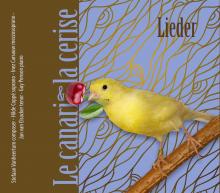Le Canari et la Cerise
Year of release: 2020
Track infoThere were several reasons for making this cd. Firstly, this recording includes all the songs for voice and piano I have written up to now. It spans a period of 30 years of creative work and illustrates the evolution of my musical writing, expression and style….. Secondly, I was privileged to work with outstanding performers. This CD therefore presents my work under the best possible conditions. Lastly, the recording location was the quiet but acoustically blessed chapel in Rosario in Bever, in the rural south of East-Flanders in Belgium. Rosario is the name of the B&B in the former cloister of “St Franciscus of Sales”, a nice place to rest and reflect. Arvo Pärt once stayed there on the occasion of a concert. The chapel has an exquisite Ibach piano from 1914 restored by Pierre Gevaert. Concerts and recordings are regularly organized in the Rosario chapel. This recording took place in two periods in February and May 2017.
This recording includes all the songs for voice and piano I have written up to now. It spans a period of 30 years of creative work and illustrates the evolution of my musical writing, expression and style…..I was privileged to work with outstanding performers. This CD therefore presents my work under the best possible conditions.
Many thanks to the exquisite performers Hilde Coppé (soprano), Inez Carsauw (mezzo-sopran), Jan van Elsacker (tenor), Guy Penson (piano). Professional recording and the mastering was excellently done by Michaël Penson, artwork by Katrien Blontrock.
Some explanations regarding the different songs.
4 songs for high voice and piano (1986-1988) text Rainer Maria Rilke (1875-1926); Opus 1 nr 1. Rilke’s poetry is generally well suited as a basis of a musical composition. The four chosen texts generate a melancholic and romantic feeling and this is also the style in which the songs (lieder) have been written. They are for high voice and can be sung either by tenor or by soprano/mezzo. The four songs have been orchestrated and a live recording on CD is available (CD includes live recording of the ‘Stabat Mater’ of April 2016).
“Ophélie”, song for tenor and piano (1986) text Arthur Rimbaud (1854-1891); Opus 1 nr 2. This is a song for tenor and piano, using the beautiful poem by Arthur Rimbaud telling the story of the unfortunate Ophélie. This poem is written in an exquisite French language and this triggered the post-impressionistic musical style.
“Love song cycle”, 10 songs for tenor/soprano and piano (1995); various English poets; Opus 3 nr 2. The cycle of ten love songs is a selection of English love poems from a book edited by Jon Stallworthy (published by Oxford University Press). The composition is dedicated to my wife Monica who gave me the book as a present. The idea behind the selection of the 10 poems is the circle of love and life, from the early and turbulent feelings (Brown Penny, First Love, The kiss, A drinking song) to the mature love (Aubade, Did not, When we two parted, when you are old) and –eventually- the last goodbye (After long silence and Remembrance). The musical language is best described as postmodern, heptatonic music. This cycle uses E major as a starting point. The earlier used post-romantic and impressionistic styles are abandoned. Although, in that period I used twelve-tone techniques for pure instrumental pieces, being a singer I could never convince myself that such technique was in-tune with the human voice. Therefore, I developed a language based on an initial key. Heptatonic series based on this scale are used for both melody progression and accompaniment developments.
“Two songs”, for alto and piano (1997); Opus 4 nr 4 Chanson de Barberine (Alfred de Musset 1810-1857) For these songs I used two French poems by Alfred de Musset and Charles Baudelaire using the same compositional technique and musical language from the love song cycle.
“Le Canarie et la Cerise”, five songs for soprano/tenor and piano (2000) text Paul Neuhuys (1897-1984); Opus 6 nr 3. The 5 poems of the poetry cycle ‘Le Canari et La Cerise’ were used in the Neuhuys songs cycle. To capture the extravaganza and expressionistic style of these poems, the musical language is similar to the love song cycle but more luxurious.
“Oimè”, song for soprano/alto/tenor and piano (2017) text Francesco Petrarca (1304-1374); (poem 267 from the Canzoniere (written +/- 1348) Opus11nr2 This song uses a key poem by Francesco Petrarca. It is the central poem in the cycle ‘Canzoniere’, the well-known cycle of 366 poems dedicated to Laura, the woman he so dearly loved. In this poem, situated in the middle of the cycle, Petrarca realizes he has lost his beloved Laura forever (she died in 1348, only 38 years old). The musical language and setting is again postmodern and includes voluptuous modulations. It was especially written for the voices and accompaniment that were available for the recording of this CD: soprano, mezzo, tenor and piano. The music is based on more traditional harmonies, seasoned with a personal approach of modulation and melody formation. It can best be described as an expressionistic style.
